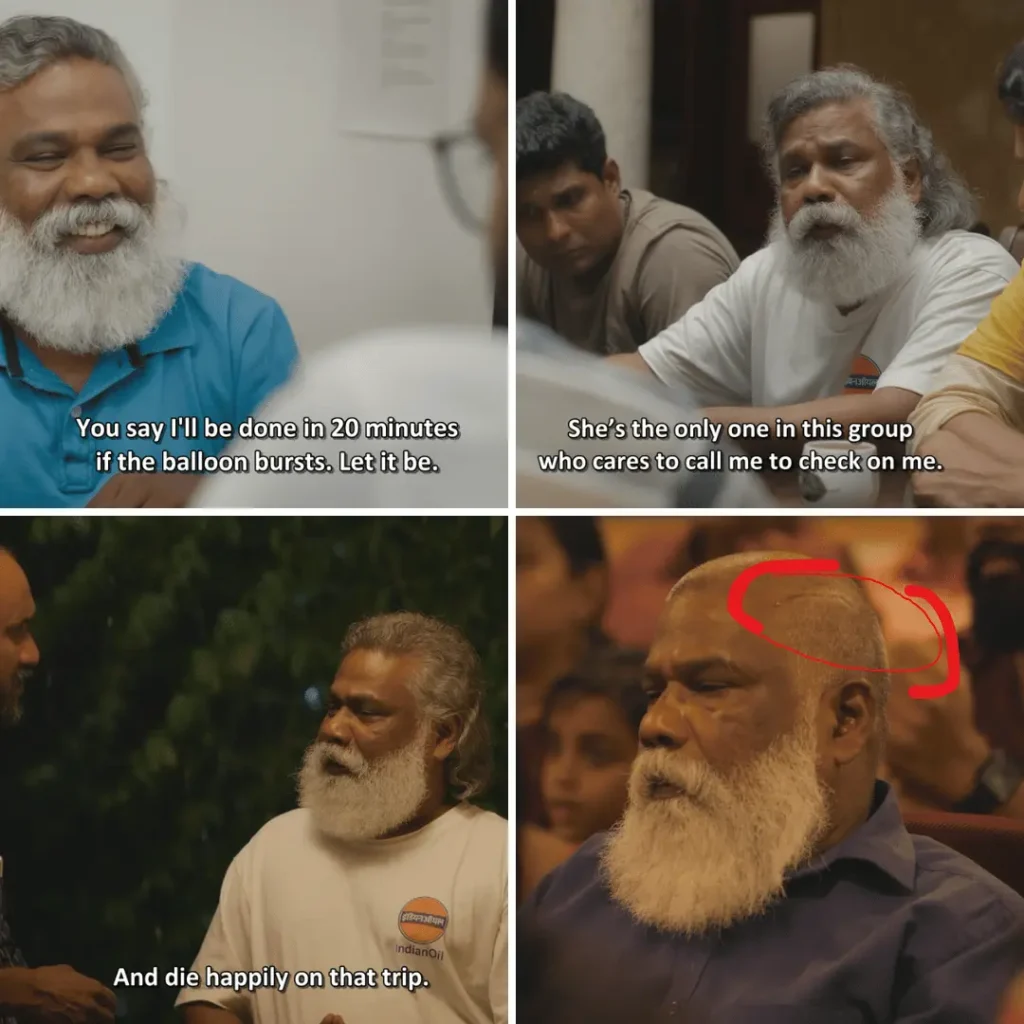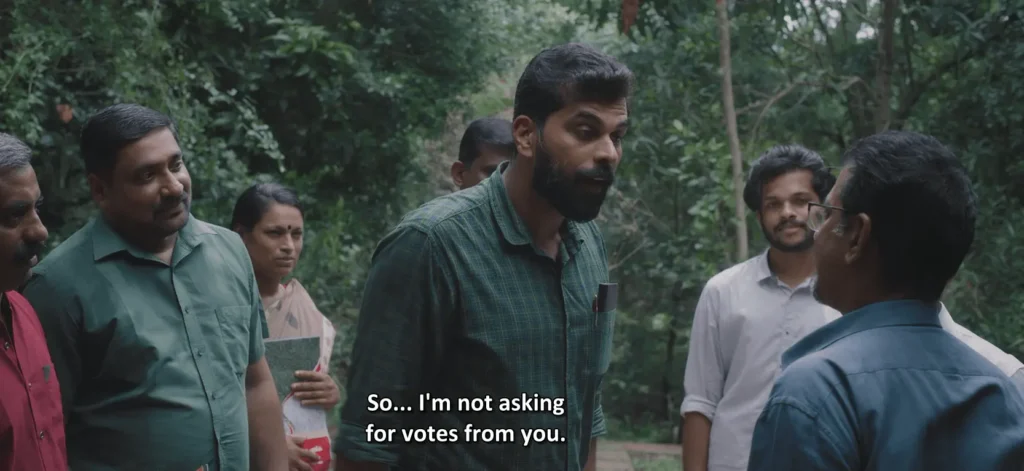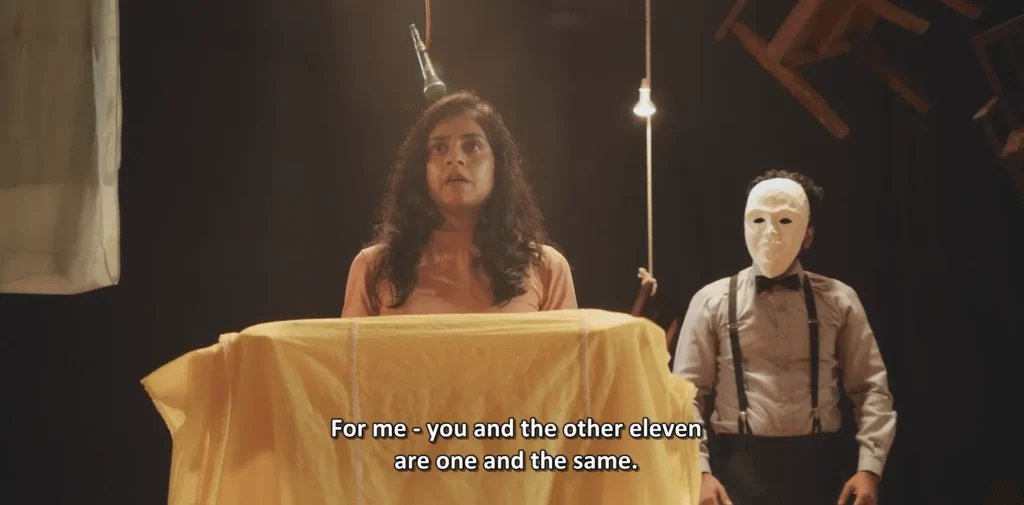
If you ask me, which is the brilliant Malayalam film from the 2024 first quarter, I would say it’s Aattam. Aattam is a 2024 Malayalam suspense chamber drama. Penned by debutant director Anand Ekarshi, Aattam navigates through the politics of gender dynamics, patriarchy, situational morality & selfishness in humans, within a theatrical setting. If you have seen this movie, most viewers ask a question: Who is the culprit in Aattam. Let me explain the layers of Aattam first, and if you are impatient, just scroll down.
Plot Overview
Aattam is a thriller of accusation and betrayal set against the backdrop of a theatre troupe. The plot circles around Anjali, the group’s only female actor, levelling charges of sexual harassment against a newly joined popular movie star in their team.

What starts as a straightforward allegation soon spirals into a complex web of deceit, manipulation, and shifting loyalties, especially when the proposal of a European tour throws the troupe into moral disarray.
The narrative cleverly employs a classic whodunit structure, yet the way it unveils the innate biases and hypocrisy of its characters is what makes it interesting.
How Aanand, wrote each character is truly admirable; for example, the character Aji (the eldest among them): Aanand constructed the character through micro interactions (mentioning phone calls, his mannerisms, etc).

At the same time, Aji’s transformation didn’t go well (someone who doesn’t care about dying suddenly willing to compromise on himself so that he can go to Europe is a bit forced, in my opinion). And all this was just so that he could say what he said at the end.
Finding The Culprit & Theme of Aattam #Whodunnit
Aattam is not about Whodunnit; by the end of the film, if you are just curious to know Whodunnit, then I would say this film is not for you. This film is not about the sinner; rather, it’s about the sin.
It’s like wondering if Teddy Daniels in Shutter Island chooses to live in a lie or faces the truth in the end. The real question isn’t what reality he picks. It’s about Teddy reaching a point where he prefers peace over constant torment, regardless of whether his world is real or made up. So, he makes a choice that might lead him to a lobotomy, showing he’d rather forget than live with the pain.

The movie is sprinkled with so many minor flaws in human interactions, be they judgmental, generalisation based on experience, selfishness, hypocrisy, vigilantism, patriarchal mindset, social influence, arrogance, or demeaning others.

Even in the way he shows patriarchal ideologies in all layers of society, for example, there is a scene where a politician requests Madan’s vote, saying, Come and vote for me with the same finger that you have voted for my father.
By the end, when Anjali says: “നീ ആരാണെന്ന് എനിക്കറിയണ്ട. നീയും ആ 11 പേരും തമ്മിൽ ഇന്നെനിക്ക് ഒരു വ്യത്യാസവുമില്ല”

The director Anand Ekarshi summarises the movie there. But if you are curious to find the culprit from Aattam, I will help you. Scroll down straght to the last sub-heading.
12 Angry Men v/s Aattam
Aattam is very similar to the classic 12 Angry Men, be it the style, theme, and narration. It’s evident that Aanand Ekarshi is highly inspired by 12 Angry Men.
The film 12 Angry Men exemplifies many social psychology theories. This tense, compelling film, features a group of jurors who must decide the guilt or innocence of the accused.

Initially, eleven of the twelve jurors vote guilty. Gradually, through heated discussion, the jurors are swayed to a not-guilty decision. Upon examination, the film highlights social psychology theories in areas of conformity, attitude change, and group processes.

Don’t you think it’s the same structure that Anand is following here?
When the inverter stops working, everyone leaves the house and steps outside due to the heat. Later, when it starts to rain, everyone rushes inside the house. These 2 scenes are one of the few scenes in which background music can be heard.
I think the director Anand Ekarshi wants to emphasise these 2 scenes, to show how we change our stance depending on the situation. The whole team was sure about throwing out Shajon’s character initially, but when the London Trip was introduced, everyone changed their stance.

A similar scene you can see from 12 Angry Men, where they open the windows because it’s too hot inside, and they open up the windows.
This shows that we humans change our stands as per our needs. This is where, I thought it would have been great if there were a couple of women who initially stood with Anjali and then turned their backs after the European trip offer came, It would better show that most people are hypocrites, not just men.
Attitude Change and Persuasion in the First Half
The central route to persuasion is all about logic and reason. It’s where you convince someone by using strong arguments, evidence, and facts to back up your position.
In the first half, you can see that Madan, Sijin, Jolly and Santosh are doing this.
For example, Sijin asks Madan: “What exactly did she tell you”, or Jolly asks: “So it happened not when she was awake”

The peripheral route of persuasion is the opposite of the central route. It’s a shortcut to influencing someone, relying on indirect cues and associations rather than strong arguments.
It targets our emotions and biases, and doesn’t require much effort from the audience to process. Vinay, Aji, Nandan, Sudheer, and Selvan are following this route.
For example when Nandan says: “He will do it, he always shares bawdy jokes”. or Selvan says: ” A sober mind wouldn’t do such things, it happened becuase they were drunk”. Through the use of non-factual, environmental cues, the sick gentleman utilises the peripheral route to persuasion.

Another important factor is Social loafing. It describes a situation where people exert less effort when working in a group compared to working alone. It’s like slacking off a bit because you think others will pick up the slack.
Prashanth and Jolly are in that stage, where they are slacking off with excuses.

And by the end of the first half, you can see group polarisation.
Imagine you and your friends are discussing a movie. Some might initially like it a little, some might be neutral, and a few might dislike it. Through discussion, those who liked it a little might become more enthusiastic, and those who disliked it might become even more critical. This is group polarisation.

Vinay brilliantly polarised everyone in one direction, by the end of the first half.
Moral Disengagement in The Second Half
Throughout Aattam, you are going to witness a few complexities in human behaviours like Moral Disengagement and Hypocrisy.
What is moral disengagement?
Moral disengagement is basically a fancy way of saying someone talks themselves into believing ethical rules don’t apply to them in a specific situation. It’s a psychological process that lets people act unethically without feeling bad about it.

Moral justification: Coming up with reasons why their actions are good, even if they aren’t. In Aattam, how conveniently the characters brought different reasons after they got to know about the European trip.
Observe how Selvan, Madan, Aji and Jolly. For instance, Jolly, the silent guy in the first half is aggressive and says “Just swallow the story in the whole”.

Euphemistic labelling: Using nicer words to downplay the seriousness of their actions. For example when Madan talks about “Tactile Halluccination” he is trying to nullify her arguments in a sweeter way compared to Santhosh and Sijin.
Discrediting the victim: This involves downplaying the harm caused to the victim or portraying them as deserving of the negative consequences.
For example, Selvan saying about Anjali’s drinking habit, Prashant talking about her relationship with a married man, Sijin talking about her relationship, even addressing her as “Set-up”.

Disregarding or minimising consequences: This involves downplaying the negative outcomes of the action. For example, Vinay saying Anjali ” No one did anything to you, let’s believe it like that.”

I really love that scene where Anjali asked the question to vinay: “If it’s not Hari, who was it? , no one raised this question”. this is where the brilliance of the script, in the beginning, everyone was talking about the punishments, but when they realised it’s not Hari and one among them, they conviniently went through the moral disengagement and forgot the whodunnit part.
Who Is The Actual Culprit: Aattam Ending Explained
If you really want a culprit, let me share some thoughts:
In the final scene of the movie, in Anjali’s drama, the culprit confesses while Anjali is holding a yellow cloth. There is only one character in the whole movie who is wearing a yellow dress. Is that the culprit?
That’s not a rational finding, right?
Okay, one more theory:
Anjali said, there was an intense perfume smell. Guys who fell in the pool won’t have that intense smell.

Jolly, Sudheer, Prashanth and Vinay were the people who didn’t fall in the pool.
Let’s eliminate Vinay, since, he is her lover. Jolly was busy with his video call and was disturbed, so let’s eliminate him.
Now either it should be Prashanth or Sudheer. Sudheer and Prashanth are the ones who got disturbed while hearing this, and went out for smoking.

I believe it’s Sudheer. WHY?
During that party, Sudheer was disturbed by seeing Anjali’s cleavage, that disturbance can be an arousal as well. Sudheer tried to hide the evidence in the first half, without any rationality. Near to the climax, while Jolly is showing the screenshot to others, Sudheer acts like he is seeing the first time. He was in a hurry to establish Hari as the culprit. He consistently avoided involving the police.

Being a smoker, Sudheer knew that Hari kept cigarettes in his car. He likely stole the car keys before the other person retrieved them.
Additionally, Sudheer watched pornography just before the incident. that was revealed later. Madan is asking why Nandhan went to Shajitha’s room, if we place Sudheer in Nandhan’s place, we have an answer: Sudheer might have gone there to see his wife and might have seen Anjali.
So, I believe it’s Sudheer. But let me remind you that the essence of film is not #Whodunnit
“നീ ആരാണെന്ന് എനിക്കറിയണ്ട. നീയും ആ 11 പേരും തമ്മിൽ ഇന്നെനിക്ക് ഒരു വ്യത്യാസവുമില്ല” 👌 { “I don’t need to know who you are. You and those 11 people are all the same to me today.” – Anjali }